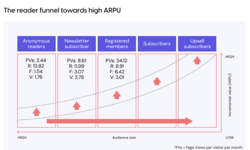
Q: How has the practice of subs marketing evolved over the last ten years?
A:
Looking at the change in sales revenue mix is a good place to start. In most cases, advertising and retail sales haven’t grown in the last ten years. Sales revenue growth has been generated by subscriptions, merchandising, and (before Covid changed everything) events. And, because of this, subscription marketing has become a recognised discipline, based on well-established direct marketing principles like campaign planning, testing, implementation, measurement, and data analysis.These principles make good business sense and the huge growth in subscriptions across lots of different market sectors has proved this to be true. There’s even a name for this approach… “the subscription economy”.
Subscription sales have increased dramatically in the last ten years and it’s good to see subscription marketing staff influencing business development strategies of the companies they work for. In the old days, subscription marketing staff were just expected to implement strategies devised by other people.
It’s good to see subscription marketing staff looking in detail on all aspects which affect acquisition rates and retention rates (prices, term lengths, payment methods, marketing channels, order channels, promotion designs, trial policies, onboarding policies) and working out which variables have the most influence on results.
It’s also good to see that subscription marketing is now a recognised career and top jobs in publishing and media companies are now being filled by former subscription marketing people.
Q: Covid has led to big increases in subs volumes. What advice would you give publishers on the best way to retain these newfound subscribers?
A:
Keep on stressing the benefits of subscribing. And keep on delivering content and community which subscribers want.Q: Why is LTV such an important metric?
A:
We can use lifetime value calculations to prove to finance directors, through actual real-life numbers, that investments in subscription acquisition campaigns generate a financial return, either this year, next year, or the year after.The entire subscription marketing process is measurable and makes complete financial sense. Finance directors can see the benefits of spending £10,000 on a subscription acquisition campaign if that generates £20,000 in two years’ time. And, on the other hand, to avoid spending £10,000 on a subscription promotion idea with little or no hope of financial success.
I’ve lost count of the number of times I’ve used a simple LTV worksheet to persuade a publisher not to spend money on an idea they thought was going to work. Learning through financial simulations is so much better than spending money now and finding out afterwards that the idea they thought was going to work didn’t. That’s an expensive way of learning!
Q: What three changes could the average publisher make to best improve their subs performance?
A:
What a good question! And after working with more than 400 publishers, I’ve seen first-hand what works and what doesn’t…- Calculate the financial effects of different subscription development scenarios (such as price, term length and payment method changes) and select the combination which maximises profits or growth
- Hire subscription marketing staff with numerical skills, proficient in Excel and the common sense to spend the company’s money as if it were their own
- Don’t be tempted to cut fulfilment costs – effective subs management systems and service bureaux increase subs lifetime values and are well worth investing in. A more effective fulfilment solution would help you increase retention rates, for example, and this would easily pay for additional fulfilment costs
Q: What does good look like? In your experience, what are good performances in terms of renewal rates?
A:
In my mind the word “good” means “predictable”. Subscription businesses have predictable revenues and costs. And that makes them less risky and much more valuable as a result.This is how we can predict subs revenues:
- Use fulfilment data to calculate the timing of revenue release from deferred income
- Use fulfilment data to determine when existing subscriptions expire, group-by-group
- Use fulfilment data to calculate percentage retention rates, group-by-group, taking care to use contract-to-contract retention rates and annualised retention rates in the correct way
- Calculate month-by-month subs renewal volumes, using data from steps 2 and 3 above
- Calculate month-by-month subs renewal revenues, using pricing assumptions together with data from step 4
- Use LTV calculations to determine how many new subscriptions will start month-by-month for the next couple of years, and from which acquisition campaigns
- Calculate month-by-month new subs revenues, using pricing assumptions together with data from step 6 above
- Use fulfilment data to determine cross-sell activity
- Calculate month-by-month merchandising revenues, using data from pricing assumptions together with steps 4, 6 and 8 above
- Total subs volumes = 4 + 6
- Total subs revenue = 1 + 5 + 7 + 9
- Total subs yield = 11 ÷ 10
Following these steps, you should be able to calculate next year’s subscriptions revenue with an accuracy of around 99%. That’s predictable!
Q: In their different approaches to subs marketing, what can B2C and B2B learn from each other?
A:
B2C publishers can test different ideas. Many / most B2B publishers can’t because test results aren’t statistically valid. B2C marketing staff rely on data analysis. B2B subs marketing staff rely on intuition and judgement. Each group would benefit by exchanging ideas and best practice in this area.Those fortunate subscription marketing staff with both B2B and B2C experiences are particularly valuable.

About us
Alan Weaver Associates are specialist business consultants for subscription-based publishers and experts in subscription marketing, subscription fulfilment and subscription forecasting.
We’ve helped more than 400 print and digital publishers around the world to increase their subscription volumes, revenues and profits, and we’ve trained over 2,000 subscription marketing staff.
We provide:
- Expert subscription marketing advice
- Expert subscription management system advice
- Excel-based subscription forecasting software
… and with a proven track record of success: our clients in the UK have won the PPA subscription magazine of the year award nine times in the last ten years.
For further information:
Alan Weaver Associates
Studio 5, 15 Clerkenwell Close
London EC1R 0AA, UK
Tel: 0044 207 739 9208
Mobile: 0044 7785 736800
Email: alan@aweaver.co.uk
LinkedIn: www.linkedin.com/in/alan-weaver-ba57301










